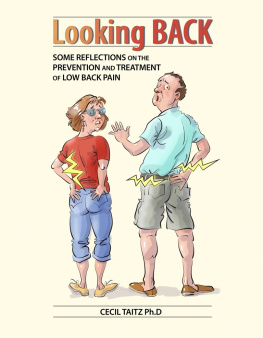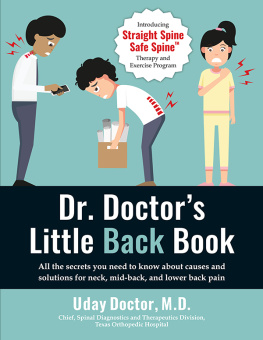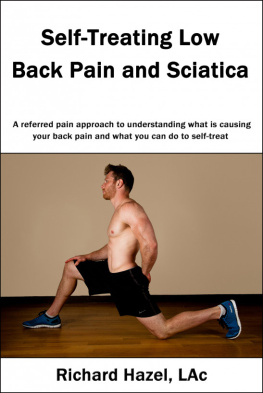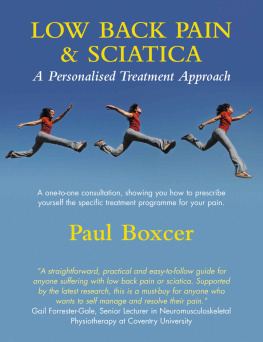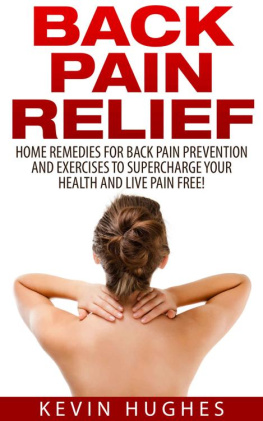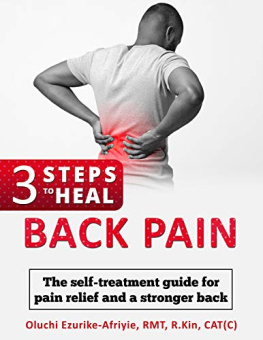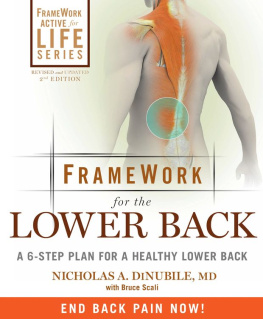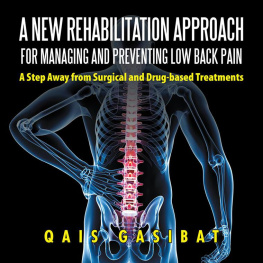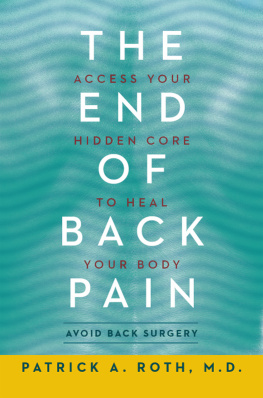Grateful acknowledgment is made to Professor Bernard Levinson for sharing his experience of the Tai Chi system of balance and coordination.
A big thank-you to Fran Milner, medical Illustrator, for her ability to bring a smile to an otherwise serious subject.
Introduction
Why another book on back pain? Why, indeed? So much has been expounded on the subject; libraries, bookshops, and cyberspace abound with words of wisdom on how to overcome this debilitating affliction, yet the incidence of back pain and cries for help continue unabated. The good news, though, is that in the majority of cases, back pain is a self-limiting condition with time as the great healer. For those not so fortunate, it is an ongoing trial-and-error regime, going from one mode of treatment to another. In many instances, particularly when pain is persistent, surgical intervention may be the only option, with varying results.
As spine pain occurs most frequently in the weight-bearing lumbar region, we could question whether our upright posture and associated bipedal gait, inherited from distant ancestors, is responsible for the back pain that is so prevalent among us today. One would expect that by now, natural selection would have operated against this susceptibility, as bipedalism appears to have been established some three million years ago or even earlier. In this regard, biologist Kenneth Miller succinctly states: Evolution has taken a spinal column well adapted for horizontal, four-footed locomotion and pressed it into vertical bipedal service. It works pretty well, but every now and then, the stresses and strains of this new orientation are too much for the old structure. Intelligent Design could have produced a trouble-free support for upright posture, but evolution was constrained by a structure* that was already there
* One should note that in standing, part of the articular cartilage of the head of the femur is exposed, whereas in the quadruped posture, the head of the femur lies completely in the acetabulum. Thus, anatomically speaking, evolution has not caught up with the true physiological position of the hip (i.e., on all fours). One could postulate that in the upright posture, the lack of congruence of articular cartilage between the femoral head and acetabulum may well be a contributing factor for the many gravity-induced hip disorders suffered later in life.
Some clinicians and nutritionists incriminate the dietary habits adopted by Western society over the past hundred years as a possible cause of heart disease, hypertension, diabetes, and some types of cancer. Similarly, it is reasonable to suggest that our back pain could partly be the result of our high-tech. cultural evolution and associated sedentary lifestyle, rather than the adoption of our upright posture. Our lives today are very different from those of our hunter-gatherer ancestors, whose way of life developed a finely tuned neuromuscular system, on which their very survival depended. In todays world, so many of us live a relatively sedentary lifestyle, with too many hours spent sitting in the car, at the computer, or in front of the television. What we have to accept is that most of us are out of touch with our bodies and thus lulled into a false sense of securityuntil back pain strikes.
It is interesting to note that the word pain is derived from the Latin poena , for punishment or penalty, as is the modern French word peine . This concept of penalty ties in with many of the Eastern philosophies, where cause and effect play an essential role in their belief systems; that is, according to them, whatever happens to us is a direct result of our own doings in this life or in a previous incarnation. With their philosophy, they learn acceptance of whatever befalls them, good or bad. You may well exclaim, What has this got to do with me? Are you asking me to accept my excruciating back pain as something I deserve? No, not at all! At the cost of being repetitive, we have to accept that a major factor precipitating our back pain is being out of sync with our bodies and, in particular, with our neuromuscular systems. At this juncture, you may well ask, What about the so-called normal degenerative changes of the intervertebral discs and joints that occur with aging? Surely no amount of training in body awareness can be of use. Well first, we have to recognize that marked spondylotic (aging) changes do not appear to correlate with back pain. Some patients may have radiological evidence of narrowing of the intervertebral discs,* osteophytosis, osteoporosis, Pagets disease, and other disorders of the spine without any back-pain symptoms. Of course, if incorrect lifting techniques or hazardous occupations are carried out with underlying spinal pathology, they may indeed lead to back pain and perhaps even surgical intervention.
Surprisingly, patients who normally complain of pain in the lumbar spine often suffer less pain with age, due, perhaps, to dehydration of the intervertebral discs and stiffening of the ligaments, which serve to immobilize the spine and thus prevent pain aggravated by movement. One should also bear in mind that back pain may be referred from other organ-related disorders, such as gynecological, prostate, hernia, or kidney stones.
* The term slipped disc, so often cited as a cause of back pain, is a misnomer, as the intervertebral disc consists of a gel-like core (the nucleus pulposus), encased in surrounding layers of concentric fibrous rings (anulus fibrosus). The entire structure is tightly bound to the bony vertebrae by accompanying ligaments and thus cannot slip. It also should be noted than in the mature human spine, there are no nerve fibers in the intervertebral disc, except for the posterior fibers of the anulus fibrosus. However, pain may be associated with the disc due to a central disc protrusion, or herniation, encroaching or impinging on surrounding nerves or nerve roots.
This book is a compendium of ideas, observations, and reflections that span many years of experience with patients suffering low-back pain. Although the cries for help of the back sufferer is not neglected, the main emphasis of the work is on its prevention through the ability to fine-tune our neuromuscular system to the changing needs of the moment , be it on the sports field or during ordinary daily activities.
With body awareness and neuromuscular harmony as our goal, its back to the drawing board to consider some definitions and fundamental aspects of the anatomy, muscle physiology, and biomechanics of the spine.
I do hope that by adopting a question-and-answer format you will be motivated to select those items of interest to you, thus ensuring easier comprehension of a complex subject. Footnotes are included at the end of each section for readers seeking a more in-depth analysis of the topic covered.

